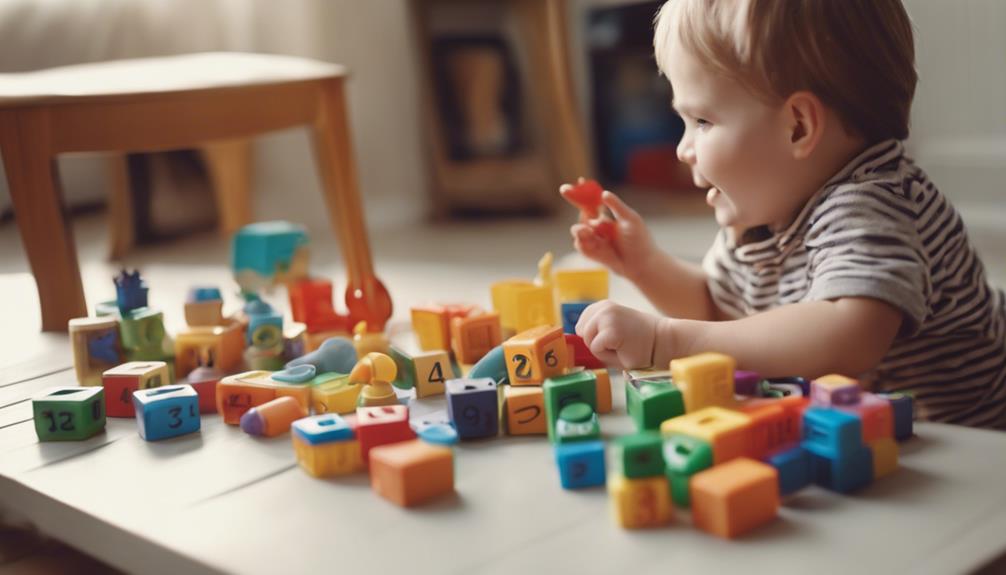Teaching your baby sign language is a great way to boost communication early on. Start with simple signs like “more,” “all done,” “milk,” or “mommy” to build a foundation. Be consistent by linking signs with everyday routines, like mealtime or playtime, and use them often alongside spoken words. Make it fun and encourage your little one with praise. Keep expanding their vocabulary and practicing regularly—you’ll find lots more helpful tips as you continue to explore.
Key Takeaways
- Start with simple, essential signs like “more,” “all done,” and “milk” to build a foundation.
- Use consistent signing routines during daily activities such as mealtime and playtime.
- Pair signs with spoken words and visual cues to reinforce understanding.
- Repeat signs regularly and incorporate positive reinforcement to encourage learning.
- Make signing fun and natural by involving facial expressions and engaging activities.
Understanding the Benefits of Baby Sign Language

Understanding the benefits of baby sign language can substantially enhance communication between you and your little one. By introducing signs early, you support your child’s language development, helping them express needs and feelings before they can speak. This early communication boosts their confidence and encourages interaction, strengthening your bond. Using sign language also reduces frustration for both of you, as your baby can share their thoughts more easily. As their communication skills grow, you’ll notice improved understanding and fewer tantrums. Plus, teaching signs promotes cognitive development, as your child learns to associate gestures with words. Incorporating portable tools for communication into your teaching routine can further support your child’s language journey. Overall, incorporating baby sign language creates a foundation for effective communication, making daily interactions smoother and more engaging for both of you.
Essential Signs Every Parent Should Know

Learning a few essential signs can considerably improve everyday communication with your baby. Many believe in sign language myths, but starting early with simple signs can foster understanding and reduce frustration. Here are four must-know signs:
- More – Encourages your baby to express hunger or desire for more.
- All Done – Helps signal when your baby has finished eating or playing.
- Milk – A crucial sign for feeding cues.
- Mommy/Daddy – Builds connections and recognition.
These signs serve as foundational early communication methods, making interactions more meaningful. You don’t need to master complex signs right away—focusing on these basics can boost your confidence and strengthen your bond. Contrast ratio plays a significant role in how clearly your baby can see and interpret these signs, especially in varying lighting conditions. Remember, sign language myths can discourage you, but starting with simple, essential signs makes a big difference.
Tips for Incorporating Signs Into Daily Routines

To effectively incorporate signs into your daily routines, consistency is key. Make your routines interactive by adding signs during activities like mealtime, bath time, or playtime. Use visual cues to reinforce learning—hold up objects or point to items while signing, so your baby connects the sign with the object or action. Repeating signs regularly helps your baby recognize patterns and remember them better. Keep your signs simple and clear, and pair them with spoken words to strengthen understanding. Incorporate signs naturally into your daily interactions, making it a fun and engaging experience. Engaging in anime culture through stories and visuals can inspire your child’s interest in communication. Practicing textile art techniques can also inspire creative ways to engage your baby with tactile and visual stimuli. Additionally, staying informed about cultural impact on artistic expression can motivate you to incorporate creative elements into your teaching approach. Being aware of toilet functionality and maintenance can help you create a comfortable environment where your baby feels encouraged to communicate through signs. Incorporating inclusive communication strategies can further support diverse learning styles and developmental needs. Over time, these routines will create a supportive environment where your baby feels encouraged to communicate through signs.
Creating a Consistent and Supportive Learning Environment

Creating a consistent and supportive learning environment is essential for your baby’s progress with sign language. Your steady model of consistency helps your baby understand and remember signs, building confidence along the way. Providing emotional support encourages your little one to explore signing without fear. To create this environment:
- Use the same signs consistently, reinforcing their meaning.
- Show patience and encouragement during practice.
- Dedicate specific times daily for signing, creating routine.
- Celebrate small successes to boost your baby’s confidence.
- Incorporate positive reinforcement to motivate your baby and reinforce learning.
- Understanding the importance of consistent sign models from related language development strategies can enhance your teaching approach.
- Recognizing the role of learning environment in skill acquisition helps in establishing effective teaching methods.
- Being mindful of effective heating solutions such as maintaining a comfortable environment can help keep your baby engaged and relaxed during learning sessions.
- Utilizing AI security principles, such as monitoring your baby’s engagement levels and adapting your techniques accordingly, can further optimize the learning process.
Progressing Beyond Basic Signs and Maintaining Engagement

Once your baby has mastered basic signs, it’s important to introduce more complex gestures and expand their vocabulary to keep them engaged. Use advanced sign techniques, such as combining signs or adding facial expressions, to deepen communication. Incorporate signs for emotional expression like happy, sad, or frustrated, helping your baby convey feelings effectively. This not only enriches their sign language skills but also strengthens your bond. Consistently model these signs during daily routines, and encourage your baby to imitate them. Keep sessions fun and interactive to sustain their interest. As your baby’s understanding grows, challenge them with more nuanced signs and emotional cues, ensuring they stay motivated and excited to communicate through sign language. Utilizing sign language resources can also help you plan engaging activities that support their development. Incorporating mindfulness techniques during your interactions can promote a calm and focused learning environment. Additionally, parental involvement plays a crucial role in reinforcing their learning and fostering confidence. Remember, integrating positive reinforcement can motivate your baby to keep practicing and exploring new signs.
Frequently Asked Questions
When Is the Best Time to Start Teaching Baby Sign Language?
You should start teaching sign language when your baby begins to show early communication cues, typically around 4 to 6 months old. This helps support their sign language milestones, making it easier for them to express needs before they develop verbal skills. By actively engaging with your baby through sign language, you’ll foster stronger communication and understanding, setting a solid foundation for their language development journey.
How Long Does It Typically Take for Babies to Start Signing Back?
You might wonder how long it takes for babies to start signing back. Usually, you can expect sign language milestones to appear around 8 to 12 months. With consistent practice, your baby begins to understand and imitate signs, strengthening parent-child bonding. Keep in mind that every baby is different, so patience is key. Celebrate small successes, and you’ll notice progress as your little one starts communicating more effectively.
Can Signing Delay a Baby’s Spoken Language Development?
Some believe sign language myths that it delays spoken language, but research shows otherwise. For example, a parent notices her toddler signs “more” at 8 months, yet reaches all developmental milestones on time. Signing can actually promote language skills by encouraging communication. You won’t hinder speech development; instead, you support your baby’s overall growth, making sign language a helpful tool rather than a barrier.
Are There Recommended Resources or Classes for Learning Baby Sign Language?
You’re wondering if there are good resources or classes for learning baby sign language. You’ll find many options, including online courses that offer structured lessons and sign language apps perfect for on-the-go learning. These resources make it easy for you to practice signs daily and reinforce your baby’s understanding. Explore different platforms to find the one that fits your learning style, making the process enjoyable and effective.
How Can Parents Handle Frustration if Their Baby Doesn’t Sign Immediately?
Did you know that most babies start signing around 8 to 12 months? When your baby doesn’t sign immediately, managing expectations is key. Stay patient and encourage small efforts, celebrating each tiny win. Remember, frustration is normal, but staying positive helps your baby feel safe and motivated. Keep practicing consistently, and over time, you’ll both enjoy clearer communication and shared joy in these milestones.
Conclusion
By starting with baby sign language, you can boost your child’s communication skills early on. Did you know that babies who learn signs often speak sooner and develop stronger bonds with their caregivers? Keep practicing, stay consistent, and make signing fun in daily routines. With patience and dedication, you’ll see your little one thrive, making everyday moments more connected and enjoyable for both of you.










